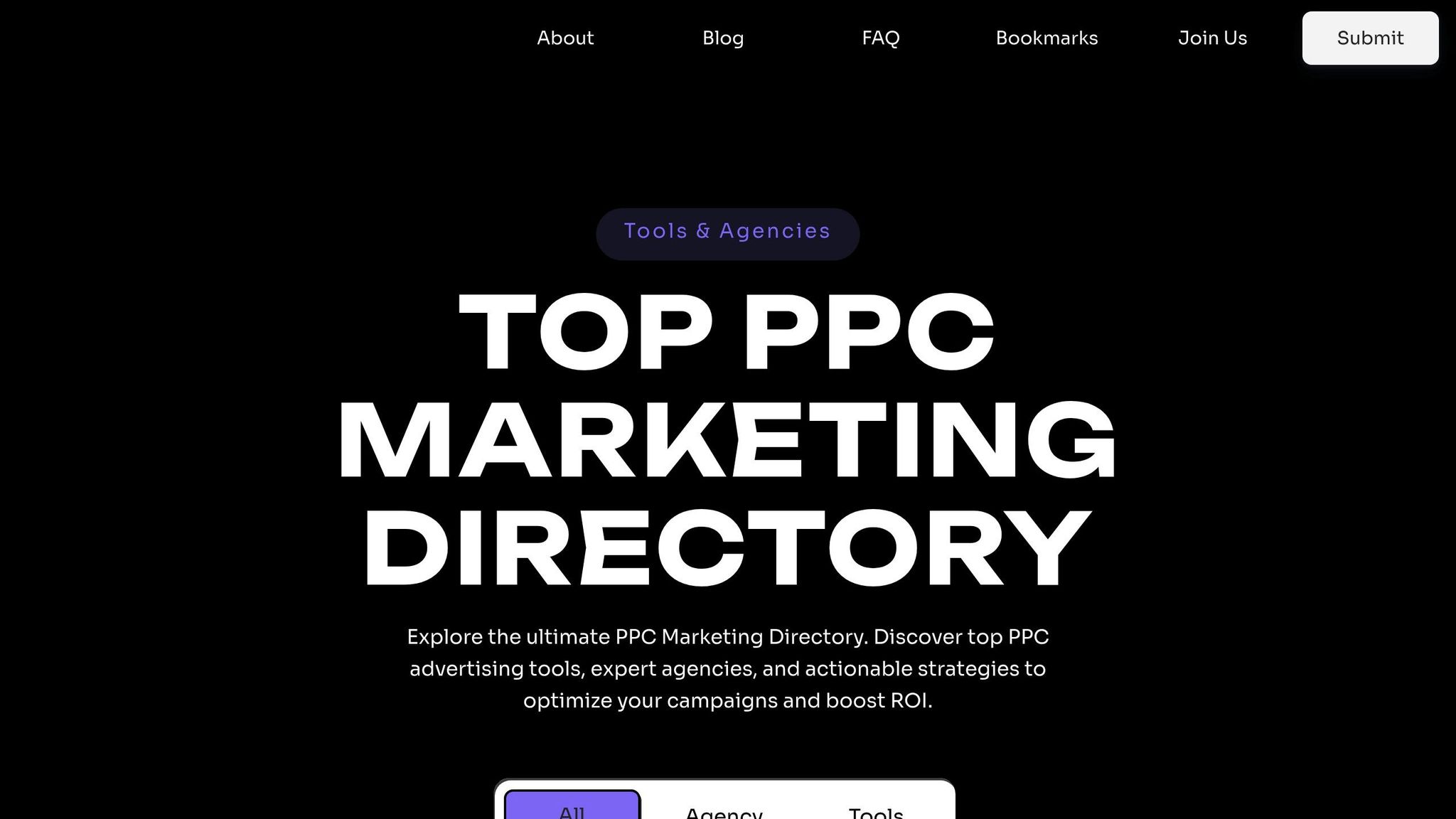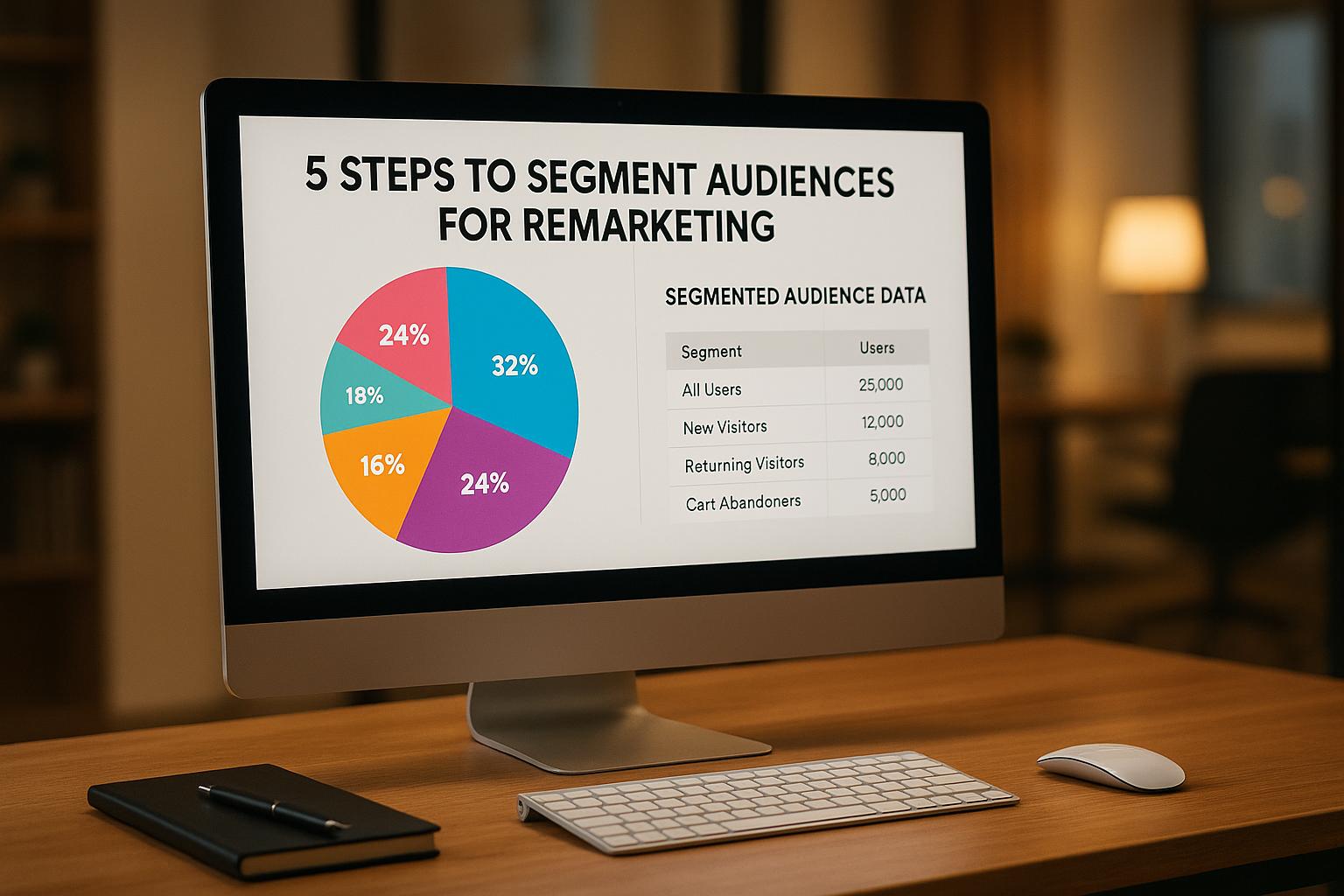Want better results from your PPC campaigns? Start by tracking the right metrics. Here's a quick guide to the key ad placement metrics you should focus on:
- Click-Through Rate (CTR): Measures how often people click your ad after seeing it. Higher CTR = more relevant ads.
- Impressions & Share: Tracks how visible your ad is and where it appears in search results (e.g., Search Impression Share, Top Impression Share).
- Conversion Rate: Shows the percentage of clicks that lead to actions like purchases or sign-ups.
- Cost Metrics: Monitor Cost Per Click (CPC), Cost Per Acquisition (CPA), and Return on Ad Spend (ROAS) to stay profitable.
- Ad Position Metrics: Analyze your ad's ranking and factors like Quality Score and bid amount.
Key Tip: Use dashboards and tools to track performance trends, compare against industry benchmarks, and make data-driven adjustments. Regular monitoring and A/B testing help refine ad placements and audience targeting for better ROI.
Read on to learn how to optimize these metrics and improve your campaign results.
PPC Metrics That Matter Most (And Least ) | PPC Jargon ...
Core Ad Placement Metrics
Knowing the right metrics is key to improving your ad placements. Below are the main metrics that influence the success of your campaigns.
Click-Through Rate (CTR)
CTR shows the percentage of people who click on your ad after seeing it. A high CTR indicates your ad is connecting well with your audience. To calculate it, divide the number of clicks by the total impressions, then multiply by 100. Comparing your CTR to industry benchmarks can highlight how well your campaign is performing.
Impressions and Share
Impressions tell you how often your ad is shown, but impression share goes a step further. It reveals how visible your ad is compared to all possible impressions, helping you identify issues like budget limits or low ad rank.
Here are key metrics for tracking visibility:
| Metric | Description |
|---|---|
| Search Impression Share | How often your ad is shown for relevant searches. |
| Top Impression Share | How often your ad appears in premium positions. |
| Absolute Top Share | The percentage of times your ad secures the very top position. |
Conversion Rate
Conversion rate tracks the percentage of clicks that lead to specific actions, like purchases or sign-ups. This metric ties directly to your business goals. To improve it, ensure clear goals, set up proper tracking, optimize your landing pages, and refine audience targeting regularly.
Cost Metrics
Keeping an eye on costs is crucial for staying profitable. Pay attention to these metrics:
- Cost Per Click (CPC): The average cost of each click.
- Cost Per Acquisition (CPA): Total spend divided by the number of conversions.
- Return on Ad Spend (ROAS): Revenue earned for every dollar spent on ads.
Ad Position Metrics
Your ad's position impacts its performance. Higher placements often get more clicks but can cost more. Balance this by monitoring your average position along with other metrics to maximize visibility without overspending.
Key factors influencing ad position include:
- Quality Score
- Bid amount
- Ad relevance
- Landing page experience
- Historical account performance
Performance Analysis and Reporting
Effective tracking transforms campaign data into clear insights you can act on.
Dashboard Setup
Create a dashboard tailored to key metrics, with separate views for different stakeholders:
- Campaign Overview: CTR, impressions, conversion rate
- Cost Analysis: CPC, CPA, ROAS
- Ad Position: Average position, impression share
- Performance Trends: Weekly and monthly changes
- Goal Tracking: Conversion targets
Use automated tools to pull data from all platforms into one place for a unified, up-to-date view.
Industry Standards
Compare your performance to benchmarks from trusted sources. Adjust these benchmarks to fit your specific niche and use them to refine your strategy.
Data-Driven Decisions
Turn performance data into actionable changes by:
- Reviewing weekly and monthly trends to identify patterns.
- Creating direct action steps from insights (e.g., increase budget if impression share is low but CTR is high).
- Measuring the impact of changes by comparing metrics before and after adjustments.
Focus on these areas:
- Pinpointing underperforming ad placements
- Replicating successful strategies
- Balancing costs with performance
- Tracking how quality scores affect results
Set up automated reports through your dashboard to highlight these points. Customize the report schedule based on campaign activity and business needs to consistently improve ad performance.
sbb-itb-89b8f36
Ad Placement Optimization Steps
A/B Testing Methods
Focus on testing one variable at a time to see how it affects performance. Key elements to test include headlines, description lines, and CTAs (like "Buy Now" vs. "Learn More"). Set up control and variant groups with equal budgets and runtimes to ensure reliable results. Let the test run long enough to gather meaningful data and confirm your findings.
Once you've fine-tuned your ad elements through testing, manage how often your audience sees your ads to maintain engagement.
Frequency Management
Avoid ad fatigue by controlling how often users see your ads. Use frequency capping to limit the number of ad views per user. Keep an eye on metrics like click-through rates (CTR) and conversion rates. If these numbers start to drop, adjust your frequency caps accordingly.
After managing ad exposure, focus on refining your audience targeting to maximize conversions.
Audience Targeting
Divide your audience into segments based on behavior (like past interactions, purchase history, time spent on your site, or cart abandonment) and demographics (such as age, location, income, or profession). Test ad placements for each segment and shift your budget toward the best-performing groups. Pair this approach with dynamic ad content to deliver more personalized messages.
These strategies help fine-tune your ad placements, leading to stronger campaign results.
PPC Campaign Tools
Effective tools help track and refine ad placements, with AI-driven automation handling multi-channel campaigns seamlessly. These tools play a key role in the optimization steps outlined below.
Top PPC Marketing Directory

The Top PPC Marketing Directory provides a collection of tools designed to monitor key performance metrics and enhance PPC campaigns. These tools address critical aspects of campaign management, as summarized in the table:
| Feature Category | Purpose | Impact on Metrics |
|---|---|---|
| Automation Tools | Simplify bid management and keyword research | Boost CTR and conversion rates |
| Performance Tracking | Track campaign metrics across platforms | Clearer performance insights |
| Click Fraud Prevention | Safeguard budgets from invalid clicks | Better budget allocation |
| Competitive Intelligence | Analyze competitor ad strategies | Improved strategic decision-making |
These tools directly improve campaign outcomes. For instance, AdNabu, featured in the directory, helped an online sporting goods retailer in March 2023 achieve a 30% increase in CTR and a 20% rise in conversion rates by leveraging AI for ad placement and keyword refinement.
"A single platform to audit, optimize, automate, and report on paid media campaigns that grow your business." - Optmyzr
Reporting Ninja consolidates data from multiple PPC platforms into custom reports, while KlientBoost shows how data-focused strategies can drive revenue growth. For automation, tools like Adcore streamline campaign optimization across Google, Bing, and social media.
When choosing tools from the directory, prioritize those offering:
- Real-time monitoring of performance metrics
- Automated bid adjustments based on results
- Cross-platform campaign management
- Customizable dashboards for tracking KPIs
- Predictive analytics for proactive adjustments
These features support smarter, data-driven decisions for ad placements, as highlighted above.
Summary
Keep a close eye on CTR, impressions, conversion rates, and cost metrics. Combine these key performance indicators with A/B testing and audience insights to get the most out of your PPC campaigns. Regular monitoring lays the groundwork for the tools and methods discussed below.
Use tracking tools and custom dashboards to streamline data collection and pinpoint performance issues in real time. These tools allow for quick, informed adjustments to campaigns across various platforms.
Key practices for tracking metrics include:
- Regular Monitoring: Check metrics frequently to identify trends and react to changes.
- Data Integration: Combine insights from multiple platforms for a well-rounded analysis.
- Actionable Adjustments: Use performance data to make precise, targeted changes.
Applying these practices ensures consistent improvements to your campaigns. As mentioned earlier, refining ad placements, audience targeting, and bid strategies based on data is the backbone of campaign success, leading to better ROI and long-term growth.


